Anna Vogt is the MCC LACA Advocacy and Policy Analyst. This post was originally published on Anna’s personal blog.
Every lunch and dinner at the conference last month included a giant bowl of iceberg lettuce. There were different dressings and toppings for the lettuce at each meal. If that had been the only vegetable option, it would have been a little sad. Instead, there were generally at least two other veggie choices and I was impressed with the variety and flavour of meals cooked for seven thousand people.
After the second meal, however, I could predict with complete accuracy the response of the majority of my Colombian colleagues every time we approached the food tables. To a one, the expression was the same at every meal: “Lettuce again? It will be so good to be back in Colombia to eat normal food.”
Every single meal I have eaten with Colombians over the past four years has been centered around rice. Until the second last meal in Harrisburg, when I finally blurted out how tired I was of rice in response to a colleague’s despair over six days of lettuce, I had never expressed my boredom with rice to Colombians.
In fact, I feel very little liberty to complain about anything in Colombian society to Colombians. I generally say nothing about air pollution, traffic, public safety, really long meetings, and especially, the food.
Colombian food is not my favourite (besides the mayonnaise flavoured potato chips). A popular dish, the Bandeja Paisa, consists of ground beef, pork rinds, fried eggs, beans, rice, sausage, arepas, and avocado. It’s not that it tastes bad, it is just greasy, salty, kind of bland, and an exercise in excess that usually involves two full recovery days, just like poutine.
Last week, I saw a woman sitting on a park bench eating cold hot dogs out of can. The same little sausages are the most popular items ordered from a colleague’s catalogue side business and have become a popular breakfast item, alongside soda crackers. Yesterday, I found, tucked inside my power bill in the mail, a coupon for a breakfast combo from a local coffee shop: a cappuccino, a deep fried pastry with cheese, and a green jello cup. When did jello and hot dogs become breakfast foods?
But more than anything, I am tired of rice. Leftover rice for breakfast, rice and pasta, rice pudding, rice mixed with tuna, chicken, salty cheese and quail eggs, with chicken flavoured potato chips on the side.
Yet is was not until I was surrounded by one hundred Colombians at the MWC Assembly, the majority very vocally expressing their dislike of lettuce and overly sweetened lemonade, that I realised that I also have a voice.
Ever since returning to Colombia, I have had multiple conversations with fellow foreigners about our fear of complaining, several of whom even gave up vegetarianism, just to make things easier for their communities. Why don’t we feel like we have a right to express our own feelings to Colombians when they often show no hesitation in expressing their feelings to us, in our home contexts? When are our personal opinions valid? Are we so afraid of creating conflict or replicating colonial patterns that we go to the opposite extreme of over-the-top praise for a plate of rice?
As I mull over these thoughts, I keep on remembering my first week on the coast. It has slowly faded into a blur of confusion, but The Great Chicken Killing Day of 2011 still stands out. I was invited to accompany the culmination of the San Pablo school’s productive project: the butchering and sale of hundreds of chickens. There were people chasing chickens, plucking chickens, killing chickens, weighing chickens and gutting chickens, yet I was forbidden from doing anything because I was the special international guest. In an attempt to make me feel useful, I was finally allowed to write down the weight and price of each chicken.
Yet when people scurried to get a fancy chair for their international visitor and wondered what they would feed me, community leader Juana waved away their concerns. “Anna can sit anywhere and eat anything. She is like one of us.” So I sat in my plastic chair and ate my chicken and rice, just like everybody else, confident (and also dreading) that doing so was one small step closer to gaining enough trust to be allowed to someday also pluck the chickens.
Over the past few years, I have meet not only chicken projects, but also other food producers (including rice) and seen the hard work, with very little profit, that they proudly engage in everyday to feed their families and their country. When I eat avocados, I think of the farmers in the Montes de Maria and the economic devastation they are facing, along with their determination to stay farming on their land. I still may not enjoy eating rice everyday, but I am trying to cultivate an appreciation for the work of the campesinos that feeds Colombia. To tell farmers their food is not something I want to eat, even when it is not the food I prefer, feels like throwing that work in their face.
Understanding food’s context makes eating with a community of food producers a joy, not a sacrifice of taste.
I do think there are moments for expressing discomfort, especially as reminders that we come from different contexts and cultures, with all of the preferences associated with those backgrounds. Looking back, I can see with clarity instances where it would have been helpful if I had stated a frustration or hesitation, instead of blind acceptance, because it would have made made things easier in the future. In my house, therefore, I invite people to try other foods and try not to be offended when they don’t like them, including the lettuce.
In a country, and a global economic system, based on class and privilege, however, I do not want to perpetuate patterns of superiority and status, where my tastes are pandered to simply because of my background. The personal is, after all, political.
Pass the rice, please.

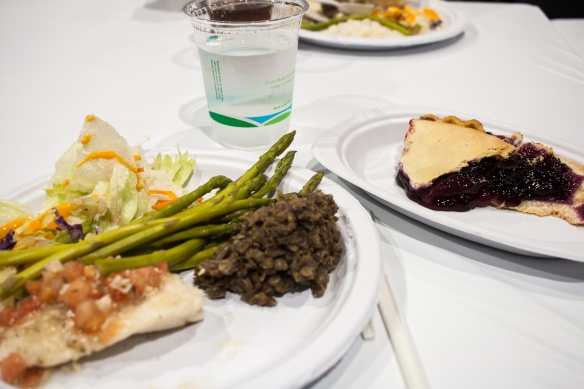
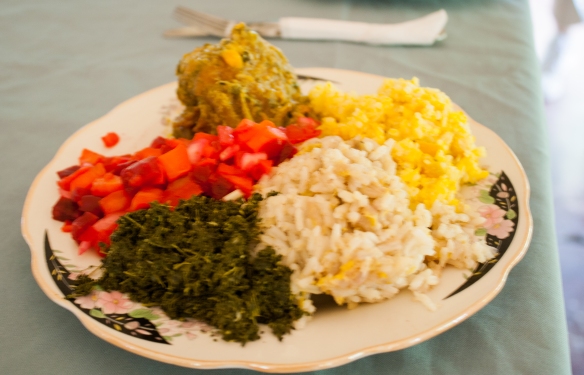
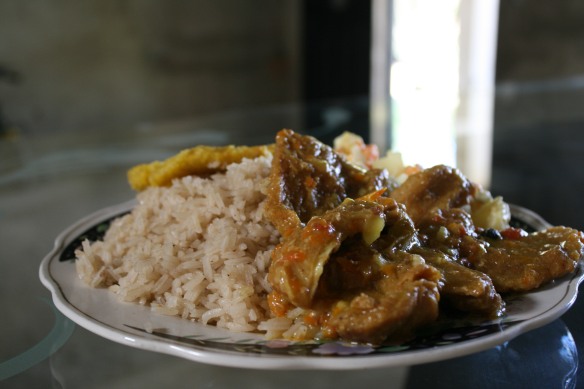
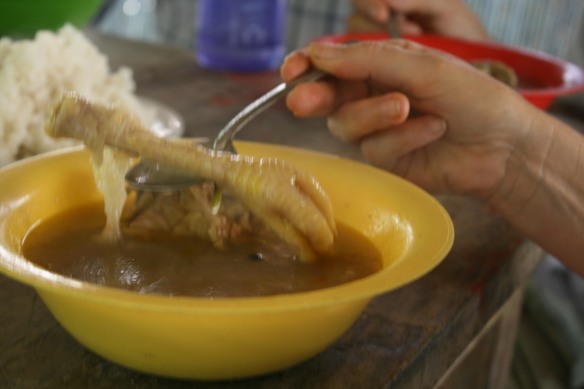

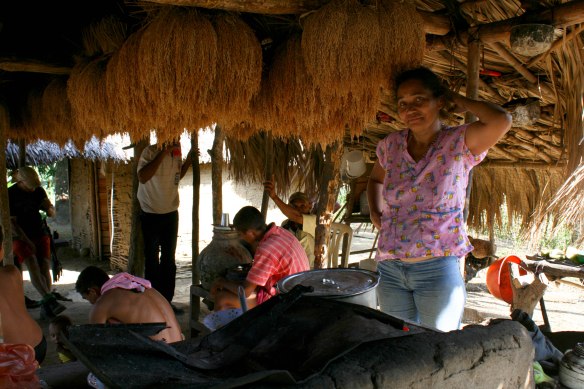
Anna, I love your blog, and always look forward to reading your thoughts, experiences and reflections. Thank you!
Re: food:
1) I’ll take Colombian rice anytime over iceberg lettuce, which is all crunch and no nutrition. Actually, I’d take anything over iceberg lettuce (except mondongo). And I’ve not yet tired of rice. But of course, “entre gusto no hay disgusto” 🙂 “to each their own.”
2) La bandeja paisa, a popular Colombian dish? Traditional maybe, but not popular. In my experience, Colombians only eat it in a restaurant, perhaps once a year! And they also call it heavy and greasy, and usually can’t finish it. A fairer listing of typical Colombian food would have included ajiaco or sancocho. In 20+ years my mom-in-law has never prepared bandeja paisa, but prepares ajiaco or sancocho for us several times during our yearly visits.
3) You ask why we can’t express our preferences in Colombia when Colombians don’t hesitate to express theirs when in the North. Good question. Among close friends, of course we can. However, in larger or guest settings, I would suggest that, coming from the Empire or the Global North, we have less legitimate space for friendly complaint of food preferences than they do here. For me, the history of “our” domination over Latin America has this type of implications. You hinted at this in your concluding paragraph.
Thanks again, y que sigas escribiendo!
Thanks for reading and responding to the blog Tim! Part of the inspiration for writing it was the way I felt after eating a mini version of a bandeja paisa at a restaurant near the office in Bogota, where it is a popular part of the daily menu rotation. Yes, san cocho and ajiaco are popular, but especially in Antioquia the bandeja paisa is also everywhere that I eaten. But I agree, and was hoping to try to demonstrate, that our personal tastes and what we eat are often more closely connected to politics and structural realities than what we think when a dish is placed before us. Instead of thinking about our immediate preferences, how can we think about were our food came from? Who grew it, either in Colombian or in the global north? How does that knowledge change how we approach that food? Those are conversations that I would like to continue to have with my friends here, about both food production in Colombia and in the north. Again thanks for reading and keep commenting!